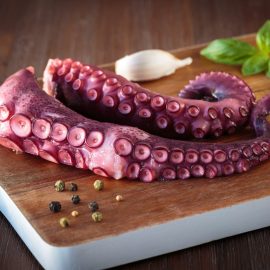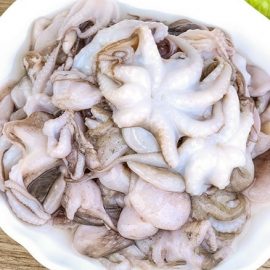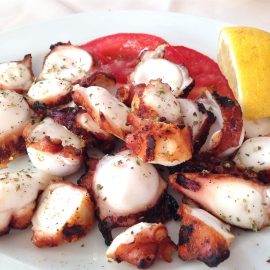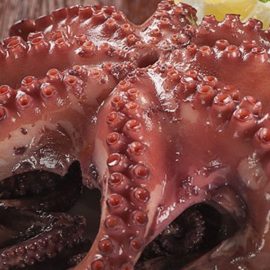
Introduction
Octopuses are a fascinating and diverse group of animals. They have been the subject of scientific research for centuries, yet much is still to be discovered about these fascinating creatures.
They are remarkable and fascinating creatures that have captivated people’s imaginations for centuries. With eight tentacles, an extraordinary ability to camouflage itself, and keen intelligence, this cephalopod is a remarkable example of nature’s ingenuity.
Description & Characteristics
The octopus is a cephalopod mollusc of the order Octopoda, genus Octopus. They have a distinct head, bilateral symmetry, and eight tentacles.
Octopuses are soft-bodied animals with no external shell or bone structure, making them adept at squeezing into tight spaces. They are typically reddish-brown but can vary in colour depending on the octopus species.
Octopuses have excellent camouflage abilities, using a combination of skin texture, colour changes, and movements to blend into their surroundings. Their bodies contain sacs of pigment cells called chromatophores that allow them to change their colours quickly.
They also can manipulate their skin texture by contracting small muscles in their skin to create bumps or ridges. Additionally, they can expel water from their siphons to rush through the water column when startled or threatened.

Species And Taxonomy
The octopus is a cephalopod mollusc of the order Octopoda. This diverse group of animals has more than 300 species, the most common being the Common Octopus (Octopus vulgaris). Though all deep sea octopuses share features, such as eight arms, they vary widely in size and colouration.
The taxonomy of octopuses is complex and still undergoing refinement. The most recently accepted classification divides them into two suborders: incirrata and cirrata.
Etymology
The origin of word ‘octopus’ is derived from the Greek language. It comes from the root ‘oktōpous’, a combination of the words ‘okto’ (eight) and ‘pous’ (foot). This aptly describes this eight-limbed sea creature, which features two rows of four tentacles each.
In modern times, octopuses are also referred to as ‘devilfish’ due to their reputation for being fierce predators.
The use of octopus as a term for this particular creature has been around since at least 1663, when it was first documented by Dutch naturalist Carolus Linnaeus in his book Systema Naturae. Since then, its scientific name has undergone several iterations, including Octopodidae and Octopoda.
Its most common name today is octopus, which has become so popular that it even appears in popular culture references such as cartoons and video games.
Biology
The biology of the octopus is a complex and fascinating subject. With their eight tentacles, intricate web of muscular tissue, and highly developed nervous system, octopuses are among the most remarkable creatures on earth.
Octopuses have soft bodies and can grow up to 3 meters in length, although most species measure only 30 cm or less in size. They have a well-developed brain that can learn and remember certain behaviours through experiences. Their eyes are similar to those of humans, but they don’t have eyelids; instead, they have a transparent layer called a cornea that helps them see better underwater.
The tentacles of an octopus are equipped with suckers which allow them to grip onto surfaces and make their way through tight spaces. Each tentacle has its own set of muscles that work independently from each other, allowing the giant pacific octopus to move quickly and accurately when grabbing prey or manoeuvring around obstacles. The tentacles also contain receptors for touch, taste, smell and temperature so that the octopus can detect its environment in many ways.
In addition to its tentacles, an octopus has two retractable sensory organs called “eyestalks” near its head that help it sense what’s happening around it. These eyestalks are connected directly to the brain, allowing it to make quick decisions based on what it sees or hears in its environment.
Habitat And Distribution
Octopuses are widely distributed in the world’s oceans and seas, ranging from the tropics to polar regions. Their habitat ranges from shallow waters to depths of over 6,000 meters. They can be found in coral reefs, rocky bottoms and sandy floors of the ocean.
Octopuses are known for their remarkable ability to adapt to different environments. They have been spotted living in habitats such as kelp forests, mangrove swamps, estuaries and even shipwrecks.
They can often survive in freezing temperatures, low oxygen levels, high salinity and strong currents.
Octopuses can travel large distances across oceans thanks to their intelligence and ability to use jet propulsion for fast movements through the water. This makes it possible for them to find suitable habitats with appropriate resources for survival despite threats from human activities like fishing and pollution.
Octopus’ Diet
Octopuses feed on crustaceans and molluscs such as clams, mussels, oysters, crabs and shrimp. They may also consume small fish or other invertebrates, such as worms or squid.
To capture their prey, octopuses use their tentacles with powerful suction cups that can attach to any surface. The octopus will pierce its prey with its sharp beak-like mouth before sucking out the animal’s insides.
Besides hunting for prey, octopuses, like crabs and other molluscs, also scavenge for food on the seafloor. Octopuses also need to be careful when searching for food since they are prey for many other predators, including sharks, dolphins and seals.
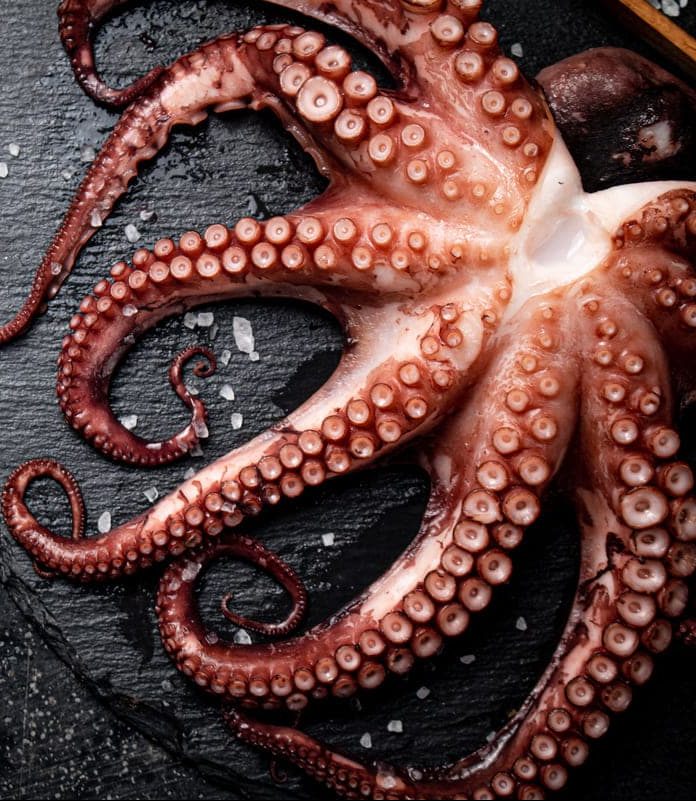
Life Cycle of Octopus
The life cycle of the octopus begins with mating, which can occur at any time of year. During mating, male octopuses use a unique arm to transfer spermatophores to the female.
The sperm and eggs are then released into the ocean water, and fertilisation takes place. As part of this process, males may undergo a period of defensive posturing and display their colours to ward off competitors from other males.
Once fertilisation occurs, thousands of tiny larvae hatch out of their eggs and drift away with ocean currents. This larval stage is short-lived as the larvae must quickly grow and find survival food. During this time, they rely on tiny organisms such as plankton for nourishment until they reach adulthood and begin hunting larger prey such as fish or crabs.
They will continue to mature over several months before reaching sexual maturity, when they can mate again.
Octopuses have a relatively short lifespan compared to other marine animals; they typically only live two to three years in the wild and up to five years in captivity. In recent years, increased fishing pressure has led to a decrease in octopus populations across the globe. They are often caught along with other species, such as tuna or shrimp, during commercial fishing trips.
Octopus Fisheries
The octopus has become highly sought-after by fisheries due to its wide range and abundance. As a result, it is widely considered one of the most commercially essential cephalopods in the world.
Octopus fishing is typically done using traps or nets onshore or offshore. Traps are often placed in shallow waters and can be baited with crabs, fish, squid, or other seafood items that attract the octopus. Nets are used when fishing for large quantities of octopus in deeper waters. Several methods for hand-harvesting octopuses from rocks and reefs, including noose-like devices, spears, hooks and lines.
Whatever method is used, careful attention must be paid to ensure that only mature animals are harvested, and that undersized individuals are returned safely to their natural environment.
In addition to being a source of food for humans and other predators like sea lions and dolphins, the octopus is also a keystone species that plays a critical role in maintaining healthy marine ecosystems. As such, it is essential to support sustainable harvest levels to not deplete local populations beyond what they can replenish through natural reproduction processes.
Sustainability
Sustainability is an important point to consider when discussing octopus. It focuses on preserving resources for future generations, which is especially pertinent in fishing and seafood harvesting. For example, a growing concern for the US Pacific Northwest is the decline of octopus populations due to overfishing and other environmental pressures. This has led to sustainable fishing initiatives such as catch limits and protected areas designed to preserve octopus populations from further decline.
In addition, sustainable seafood certification programs have been developed to ensure that seafood products are harvested responsibly. These programs assess fisheries’ sustainability and management practices, ensuring they comply with international responsible harvesting and conservation standards. Consumers can look for eco-labelled products such as Marine Stewardship Council (MSC) certified octopus to ensure that their purchase supports sustainable fishing practices. Furthermore, retailers can become MSC certified and commit to sourcing only sustainably-harvested seafood products.
The following are some key points related to the sustainability of octopuses:
- Sustainable fishing initiatives include catch limits and protected areas that prevent overfishing
- Seafood certification programs like the MSC ensure responsible harvesting practices
- Consumers can identify sustainably-harvested products with eco-labels like MSC certified
- Retailers can also become MSC certified and commit to sourcing only sustainably-harvested seafood products
Octopus As Food
Octopus is considered a delicacy in many cultures and is eaten worldwide. It has a mild flavour, with a slightly sweet taste and tender texture. The most popular way of preparing an octopus is to boil or grill it, though it can be designed in various ways.
One of the most well-known methods for cooking octopus is to simmer it in white wine or lemon juice until it becomes tender. This method enhances the octopus’s flavour and helps retain its natural juices.
Octopus can also be served raw as an appetiser or as a salad. When cooked properly, octopus should have a soft yet meaty texture that melts in the mouth.
When choosing an octopus for cooking, selecting one fresh and free from any signs of spoilage, such as discolouration or strong odours is vital. For best results, cook the octopus the same day it was purchased from the market.
Additionally, when preparing an octopus, clean and cut it properly before cooking so that all toxins are removed from its body and its flavour is not affected by any impurities. Furthermore, careful attention must be paid to cooking times so the meat does not become too tough or chewy.
How To Prepare
Preparing octopus requires knowledge and technique, which can become tough if cooked incorrectly.
The first step in preparing an octopus is cleaning the creature. Octopuses should be cleaned soon after they’re caught, as their meat can become mushy if left too long in its fluids.
To clean an octopus, rinse it thoroughly with cold water, and cut off the eyes and beak near the centre of the head using kitchen scissors or a sharp knife. After removing these parts, discard them along with any remaining entrails contained within them.
Once cleaned, you may tenderise your octopus by either pounding it with a mallet or marinating it in vinegar or lemon juice for several hours before cooking. This helps break down proteins into smaller molecules, making the meat more tender and easier to digest when cooked.
When ready to cook, boiling is one of the most popular methods for preparing octopus. However, grilling and roasting are popular among chefs who appreciate its unique flavour. Regardless of the method chosen, cook your octopus until it reaches an internal temperature of 145°F (63°C) for food safety reasons.
Once cooked, your octopus is ready for serving! With its unique texture and delicate flavour, there are numerous ways you can enjoy this seafood delicacy, from salads to appetisers such as grilled octopus skewers or roasted with garlic butter sauce. Being able to prepare delicious dishes using this versatile ingredient will give you a great sense of accomplishment in creating something unique from what was once an ordinary creature found in our oceans!

Best Side Dishes Paired With
Octopus is an incredibly versatile and delicious seafood option, especially when paired with side dishes that bring out the unique flavour of this cephalopod. From zesty salads to buttery potatoes, many excellent sides complement octopus dishes.
To truly elevate your meal, here are the best side dishes matched with octopus:
First on the list is a crisp Greek salad. The cool crunch of cucumbers and tomatoes contrasts nicely with the tenderness of octopus, while feta cheese adds a creamy finish. Another great side dish is oven-roasted potatoes. Not only do they provide a starchy base for the meal, but also their buttery texture pairs well with the mild flavour of octopus.
For a more vibrant side, try making a grilled vegetable medley featuring asparagus, carrots, and squash. These vegetables provide a sweet and earthy taste that complements octopus dishes nicely. Lastly, an octopus meal would only be complete with some crusty bread or warm focaccia to sop up all that delicious sauce!
The perfect combination of flavours can transform an ordinary meal into something extraordinary – all it takes is pairing your octopus dish with one of these mouthwatering sides. With creativity and experimentation, you can create new flavour combinations that will tantalise everyone’s palate – so go ahead and get cooking!
Popular Recipes
Popular recipes featuring octopus are often found in Mediterranean and Asian cuisines. Boiled or grilled octopus is a typical appetiser, while dishes like polpo alla Luciana (octopus with tomato sauce) and pulpo a la gallega (octopus with paprika) are popular main courses.
Octopus is also commonly served as sashimi or sushi, with the tentacles often being lightly boiled before serving. In Portugal, bacalhau com natas (codfish with cream) is a popular dish that includes octopus as one of its ingredients. Other dishes like Arroz negro (black rice), pulpo al Olivo (octopus with olives), and kalmarosalata (calamari salad) are also popular recipes featuring the sea creature. When preparing octopus dishes, it is essential to remember that the seafood can be tough and chewy if not cooked properly.
To ensure proper cooking, it is recommended to start by boiling the octopus for several minutes before adding other ingredients. This helps tenderise the meat and ensure it will be cooked when the dish is finished cooking. Depending on the recipe, one may need to simmer or fry the octopus after boiling it to achieve the desired texture and flavour. For instance, while boiling is typically sufficient for sashimi or sushi dishes, recipes like pulpo a la gallega may require additional frying techniques to achieve optimal results.
Comparison To Other Seafood
Octopus, the eight-limbed cephalopod mollusc, is so mysterious and extraordinary that it can only be compared to its otherworldly relatives in the deep sea. The octopus stands out among its fishy peers with its remarkable characteristics and unique capabilities.
The octopus’s physical features are unlike any other fish species. Its eight arms covered in hundreds of suction cups make them quite remarkable. Octopuses also have incredible camouflage abilities, allowing them to quickly change colour and texture to blend into their surroundings. In addition, their eyes are exceptional at adapting to low-light environments, enabling them to hunt for food even in murky waters.
Regarding behaviour, octopuses have demonstrated remarkable problem-solving skills and agility in escaping predators or finding food sources. They are among the few invertebrates that use tools, such as coconut shells as protarmoure armour or rocks as anchors while sleeping. Moreover, they possess an incredibly sophisticated nervous system with complex behaviours like playfulness, curiosity and intelligence that surpass many vertebrate animals.
All these unique traits of the mimic octopus make it an extraordinary creature compared to other members of the ocean’s diverse inhabitants. From their distinctive physical features to impressive mental faculties and behaviours, the octopus is an absolute marvel of nature that deserves admiration and respect.
Conclusion
The octopus has long been a symbol of mystery, intelligence and adaptability in our oceans – a true marvel that never ceases to amaze us with its grace and cunning behaviour. The ability of this creature to camouflage itself from predators while hunting prey efficiently speaks volumes about its resourcefulness; its presence reminds us of how much beauty can be found in the depths below if we take the time to look.

